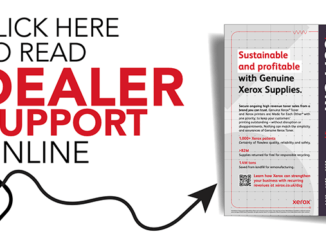
The COVID-19 pandemic has changed many aspects of how people work;, one that has, perhaps, been under-appreciated is how paper and paper products are consumed, and how customer demands have altered
While there have been ambitions to create a ‘paperless office’ for many years now, paper remains a mainstay of the office, and a regular order to office products suppliers from customers across the range of business sectors is still the norm.
Although the use of paper may have declined in some ways in recent years – for instance, many documents are now stored electronically, rather than physically, in filing cabinets – it still plays a vital role in sharing information in a physical and personal format.
“Generally speaking, people still prefer reading printed literature in comparison to virtual or screen-based printing,” explains Brad Goldsmith, marketing services manager at Premier Paper Group. “Studies suggest that reading from screens is around 20-30% less effective than reading from printed literature, although this could be subjective. However, excessive screen time is shown to impact concentration levels and eye fatigue. Uncoated papers, with a high whiteness and opacity, are perfect for reading printed text; they’re free from glare and the contrast between the print and the paper is much easier on the eyes.”
This remains important whether people work in an office or home environment. Of course, the COVID-19 pandemic has meant that many more people are now working remotely, and this has changed demand for paper products.
“There has been a significant increase in demand for multi-purpose, multi-functional sheets, with brands such as Multicopy, Navigator and Pro-Design proving increasingly popular,” says Brad. “This This is understandable, as they are incredibly versatile sheets that are perfect for a wide variety of end-use applications including reports, artwork, proofing notes and schoolwork, whether full colour or black and white prints.
“The above brands are well-established, and recognised in the market by consumers and end-users. Furthermore, they are incredibly reliable, with Pro-Design boasting a 99.99% jam-free guarantee. This level of reliability has been a big draw for customers due to the time and, therefore, cost savings associated with experiencing fewer jams, reprints and machine breaks.
“As many companies and schools continue to work and study from home, expect to see these same trends develop further – a continued demand for versatile, reliable brands of office papers that are sustainable and environmentally friendly.”
Paul Savill, product manager at paper, packaging and visual communications specialist Antalis, agrees. “The ‘new normal’ under COVID has put greater emphasis on paper, particularly if you look at our home working and schooling balancing act,” he says. “Paper is fulfilling a wider range of tasks, often on a home inkjet printer, not the centralised office or classroom printer.
“How long this will last for is, as yet, unknown. However, it would appear that our home working/schooling is set to last until Easter.”
Recycled requirement
Paul adds that there is also a growing requirement for recycled and/or sustainable papers. “Whether it be part of a corporate social responsibility (CSR) policy, or the personal preference of a more environmentally conscious home-user, the two often are thrown together for consideration,” he says. “Office papers are well represented, with certifications such as FSC, PEFC and the EU Ecolabel, what is less clear, perhaps, to the buyer is what this actually means and how to compare their respective merits.
“Future buying decisions and demand will, undoubtedly, be driven by environmental considerations and the challenge will be to educate buyers and end-users to assist them in making well-informed and balanced choices based on their particular needs and wants.
“With carbon offsetting schemes, and CO2 neutral papers, now available, the paper industry certainly has a stronger environmental focus than ever before.”
Brad agrees that CSR and sustainability continue to be big issues for individual consumers and companies alike. “Products such as Woodland Trust Printer Paper and Pro-Design continue to be popular choices among paper users due to their outstanding environmental credentials, recyclability and their direct support of the Woodland Trust and the carbon capture programme,” he says.
Changing habits
However, as Dr Liz Wilks, EU director, sustainability and stakeholder, at APP, notes, individual home working employees have their own tastes, which isn’t always for recycled. “Office papers take a different form [at home]; consumers prefer more virgin fibre products than recycled – this is also the case for tissue paper – and more premium than economy as they are not purchased en masse, as well as the higher grades consumed,” she says.
The pandemic has also changed consumer habits – as with increased online shopping, takeaway and home delivery – which brings the issue of waste into focus. “The increased online consumption, coupled home working, has thrown a spotlight on the growing problem of packaging waste, particularly plastics in food packaging,” says Liz. “Environmental credentials and content have become an even more hot topic in the paper and packaging industry.
“As we begin 2021 I hope that we can take positives out of the pandemic, such as appreciating what we do have, becoming more aware of our natural environment and taking care with our packaging and recycling.
“The things I will take away into 2021 is that, sometimes, less can be more. The way we view ‘the office’ has changed forever, and paper still has its place.”



Be the first to comment